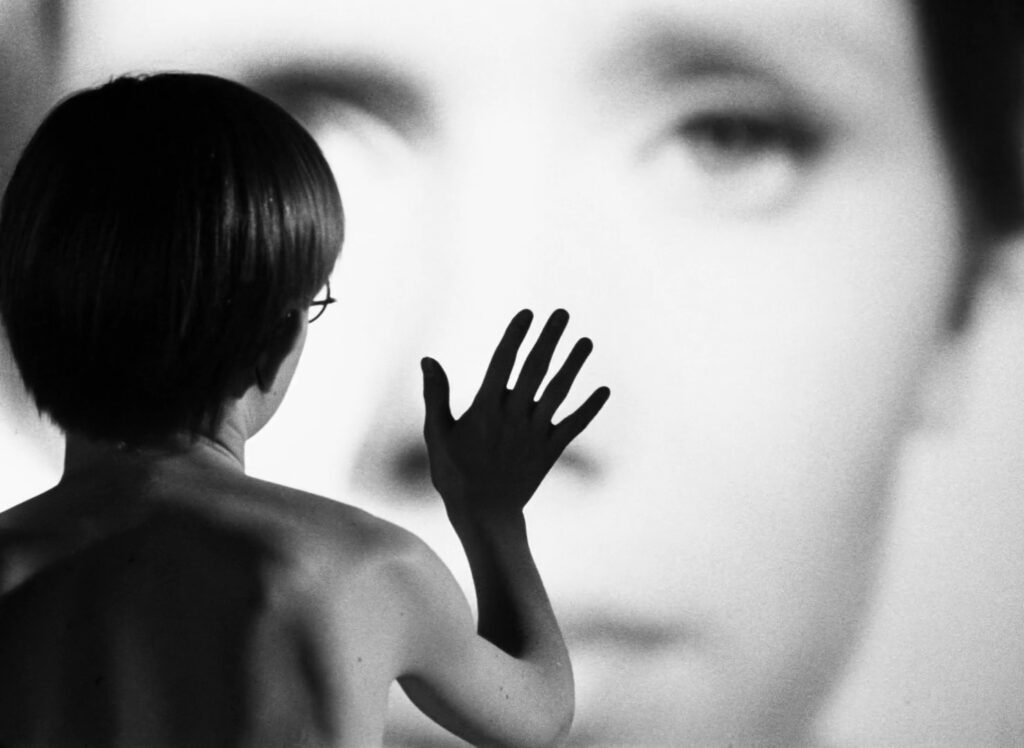
Persona
1966, directed by Ingmar Bergman
Persona is a notoriously difficult movie, but it shouldn’t be hard to figure out if we can only manage to reconcile its two seemingly unrelated threads. One thread is the main narrative in which Alma nurses Elisabet Vogler through her strange silent spell. As their emotions heat up their relationship spirals into ambiguity. The second thread is the layer of artifice that frames and interrupts the main story, mixing the human narrative with what looks like pieces of experimental film. If only the human story weren’t so well done, it would be easy to dismiss the arty bits as a nonsensical affectation. Conversely, if only Bergman hadn’t thrown in all the avant-garde footage, at least we’d have some hope of making sense of Alma and Elisabet.
However the “experimental” parts of Persona are far from random, nor are they especially difficult to read. The movie begins with carbon electrodes igniting in a movie projector’s arc lamp, followed by film reels spinning, a film strip unwinding, the countdown from a motion picture leader (the erect penis is a humorous inversion of the customary “China Girl” used to calibrate color), a primitive cartoon with the sprocket holes showing, and excerpts of Méliès-influenced slapstick with skeletons and demons. So far all signs point directly to cinema itself, and the remaining imagery – the pair of hands, the spider, the slaughtered sheep, the crucifixion, the brick wall, the snow, and the boy in the morgue – all awaken a sense of raw physicality, much as the initial imagery reminds us of the physical nature of film.
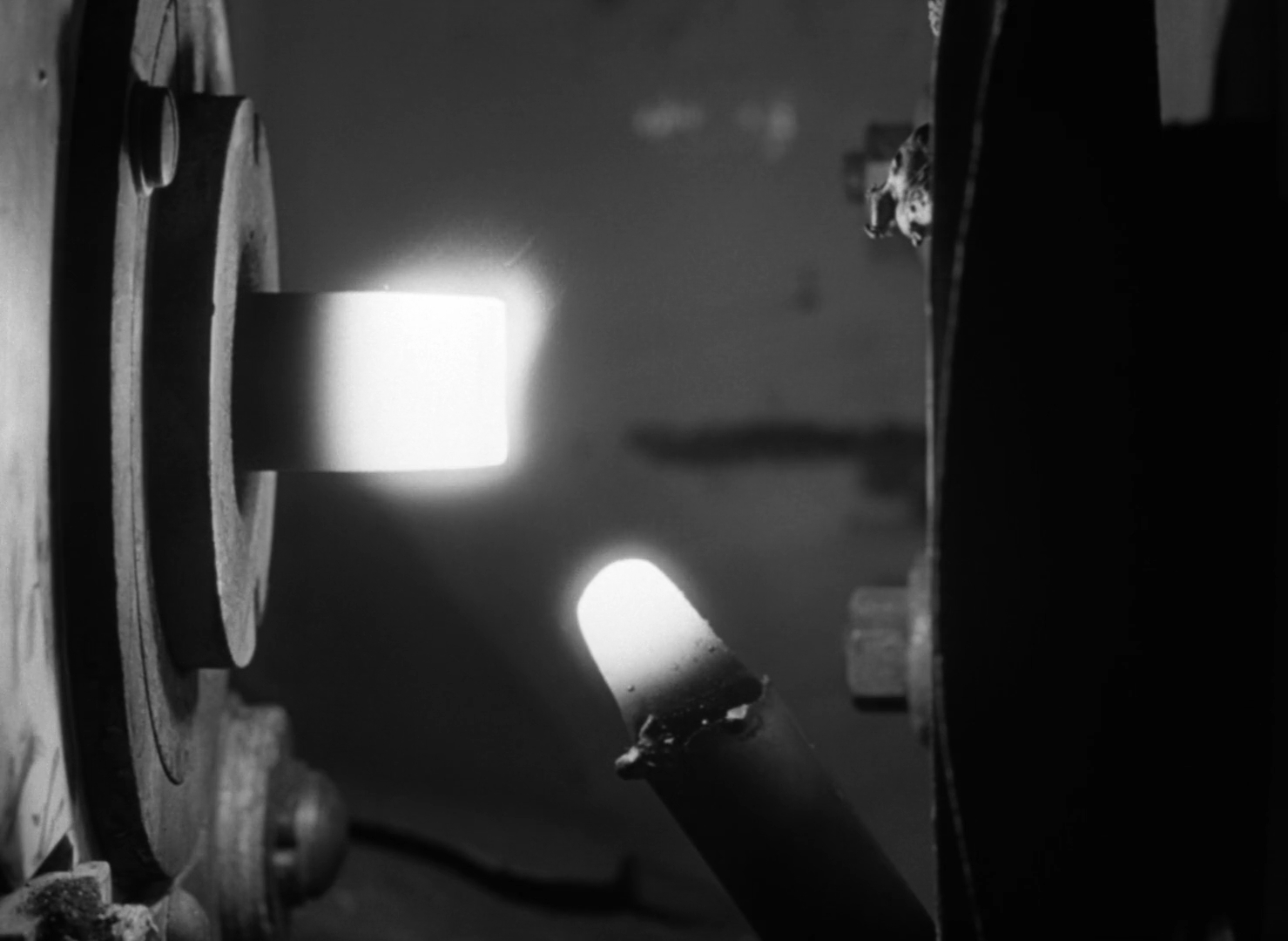

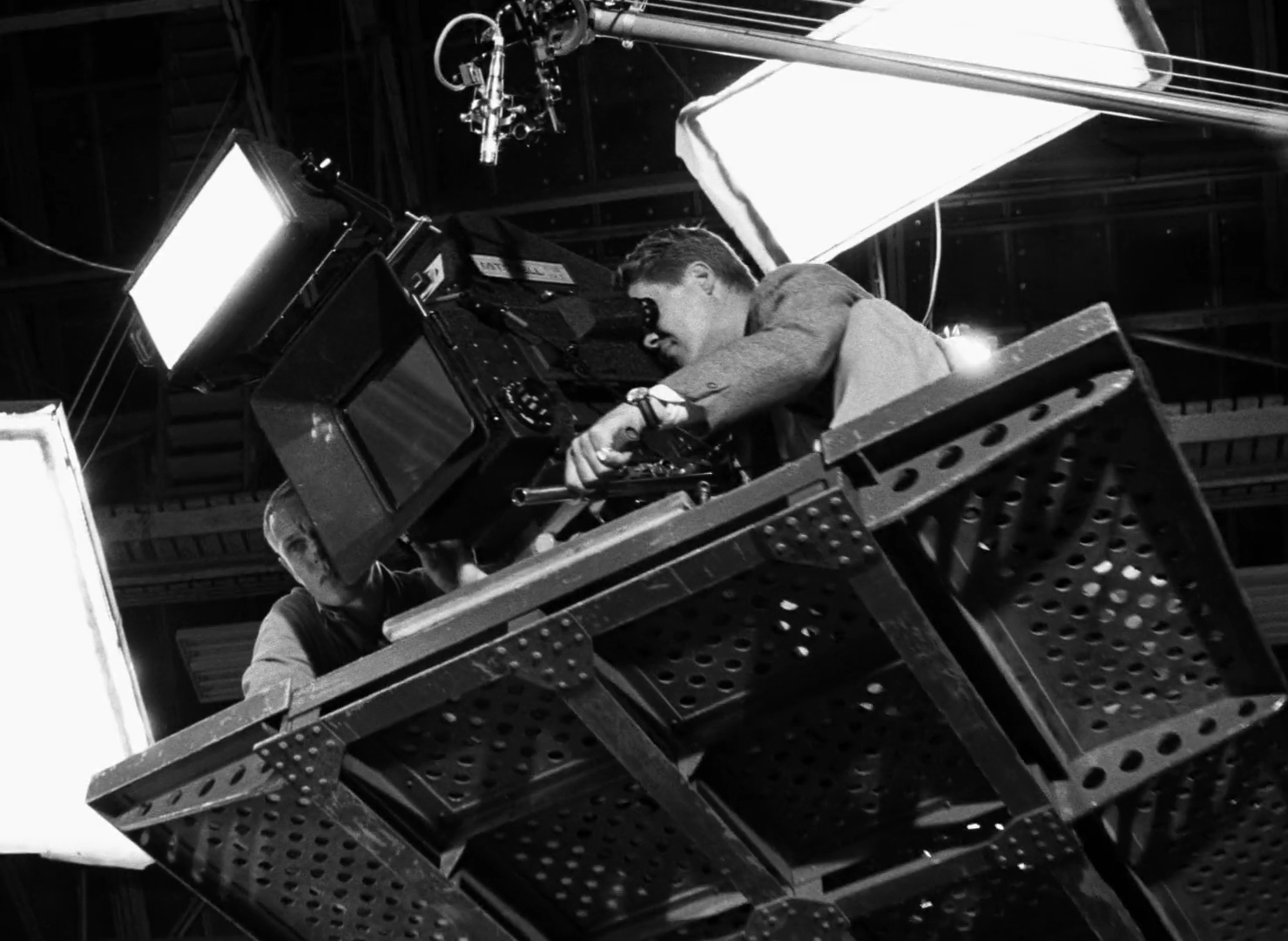
Persona switches twice more into avant-garde mode, at the middle and at the end, both times pointing again to the physicality of film. In the middle, after leaving a shard of glass in Elisabet’s path to punish her for her letter, Alma’s anger materializes in the form of ripped and smoldering celluloid, followed by a quick recap of the silent slapstick and the crucified hand. At the end a film crew suddenly appears on a crane with a large movie camera and studio lamps, and the film ends with the electrodes of the arc lamp dying out.
The effect of all this is to remind us, as viscerally as possible, that we’re watching a movie – and the effort is not limited to those three framing passages. Alma and Elisabet break the “fourth wall” by looking straight into the camera multiple times. The editing and shot framing call attention to themselves, and even the fact that Elisabet is an actress, and that the doctor speaks of her silence as a performance, adds to our constant awareness of the artifice in Persona.

If we consider that Bergman originally wanted to name the film Kinematografi, the evidence points strongly to Persona being about cinema. Nevertheless we’re left with a very different title and a story that points to broader human subjects like identity and communication. The word “persona” is derived from the Latin word for a theatrical mask, which is traditionally used to define a character, and the open question at the forefront of Persona is the definition of its two main characters. To say that the movie is merely about cinema would seem to narrow its scope needlessly, when it has so much to say about universal questions concerning life and personhood.
Here however we have the solution to our riddle. The tension in Persona stems from the question of identity – whether Elisabet can ever drop her performer’s mask and be her real self, or whether Alma’s personality can remain intact through her long encounter with Elisabet. The chief source of friction is a matter of personal boundaries, as Elisabet discloses Alma’s secret confession in a letter to the doctor. Each woman finds her sense of self getting blurred, and the loss of control upsets both of them. In the film’s most famous shot the two protagonists’ faces are sutured together into a strange chimera that encapsulates the ambiguity of their identities. This ambiguity is exactly the link that also sutures the movie’s two irreconcilable threads. Persona‘s ambition is to define cinema, and it finds the defining quality in ambiguity.
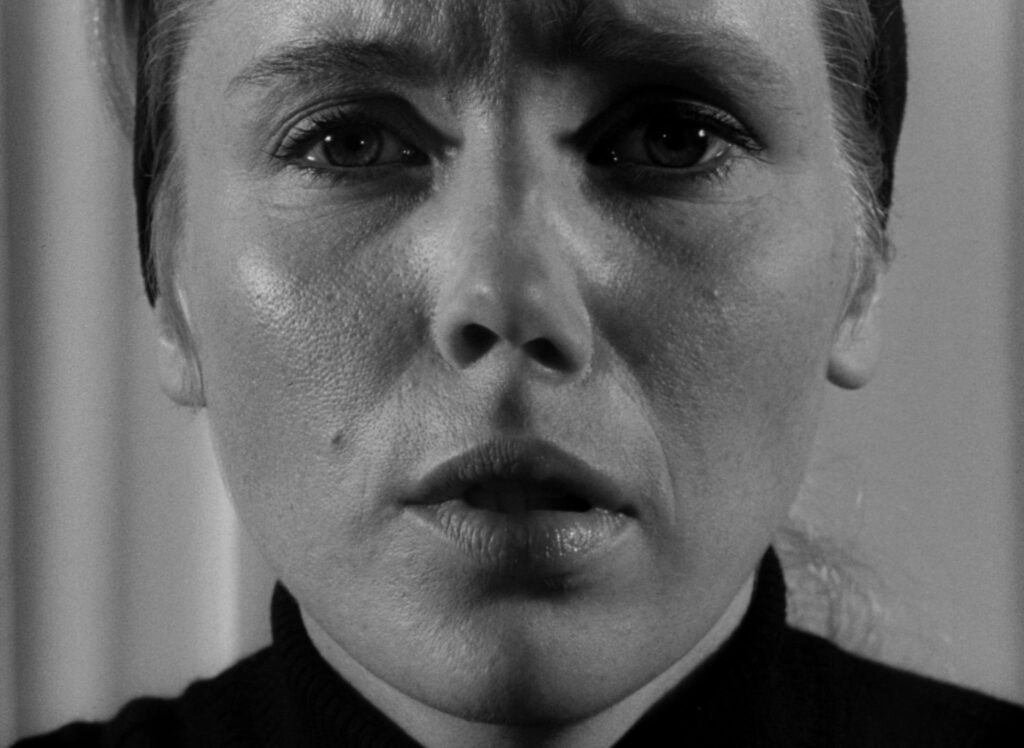
It’s one thing to define cinema in the abstract, but Persona defines it through the living example of its story and characters. To start with, Alma and Elisabet are ambiguous along almost every important axis of description:
- Who is the main character? Alma gets almost all the lines, but Elisabet’s silence defines the story, and the following two films in the trilogy trace Liv Ullman instead of Bibi Andersson.
- Who is the dominant personality? Alma has charge of Elisabet and dominates her physically, but Elisabet gets under Alma’s skin and usually dominates psychologically.
- Who is the caregiver and who is the patient? Alma is hired to care for Elisabet, but in traditional psychoanalysis the therapist remains silent while the patient opens up.
- Who is the performer and who is the audience? Elisabet is a professional actress, yet Alma finds herself performing for her.
- Whose point of view is shown? When Alma reproaches Elisabet for being a hateful mother, each point of view is shown in succession, and it’s ambiguous whether Alma has intuited the truth (as it appears from her point of view, watching Elisabet’s reaction) or whether she’s flying off the handle (as it appears from Elisabet’s vantage).
Elisabet and Alma are both disturbed by the idea of being two persons at once. Elisabet recoils on stage at the dizzying thought of being both herself and Elektra, while Alma is bothered by the literal duality of carrying a child in her womb. When she became pregnant she had aborted the child, yet she appears jealous of Elisabet for being a mother. Alma’s first emotional eruption is preceded by a shot of her body reflected in a pond, a visual correlative for being split into two persons. While each character is split internally, the two of them frequently begin to merge, not only in the famous suture but also in many shots where one face eclipses or overlaps the other.

Reality itself is often ambiguous in Persona. When Alma starts to fall asleep Elisabet’s voice whispers that she should go to bed, but it’s not clear whether Alma imagined it, and Elisabet later denies having spoken. Likewise their scene of affection in the bedroom may or may not be Alma’s imagination, and the same goes for Herr Vogler’s visit.
Persona is one of the most densely structured movies. Not only is it framed at both ends and split into two halves by the inserted experimental footage, it also displays a reflective symmetry with various details mirroring each other across the film. Toward the beginning Elisabet’s face slowly darkens by a lamp, and toward the end it slowly brightens by a lamp. A radio in the first half plays fragmentary lines about forgiveness, and in the second half the same radio plays a passage about understanding. The long tracking shot facing inland when the two women pick mushrooms is mirrored by the long tracking shot facing the sea when Alma chases Elisabet. When Elisabet watches Alma make love to her husband it vaguely reflects Alma’s story of her beach orgy.
Usually when a movie introduces structural devices, a single duality is enough – it can be broken into two halves, bracketed at both ends, revolve around parallel characters, or incorporate palindromic symmetries. Persona does all of these. Such devices enable a movie to communicate by inviting comparisons, but as we see here the purpose is not always purely semiotic. Whether a movie speaks through framing, repetition, or any other duality, it also creates ambiguity, opening dual points of view. Most of these structural devices are variations on the old idea of the “twice-told tale” of which Alma’s twice-shown rant about Elisabet’s motherhood is such a basic example.
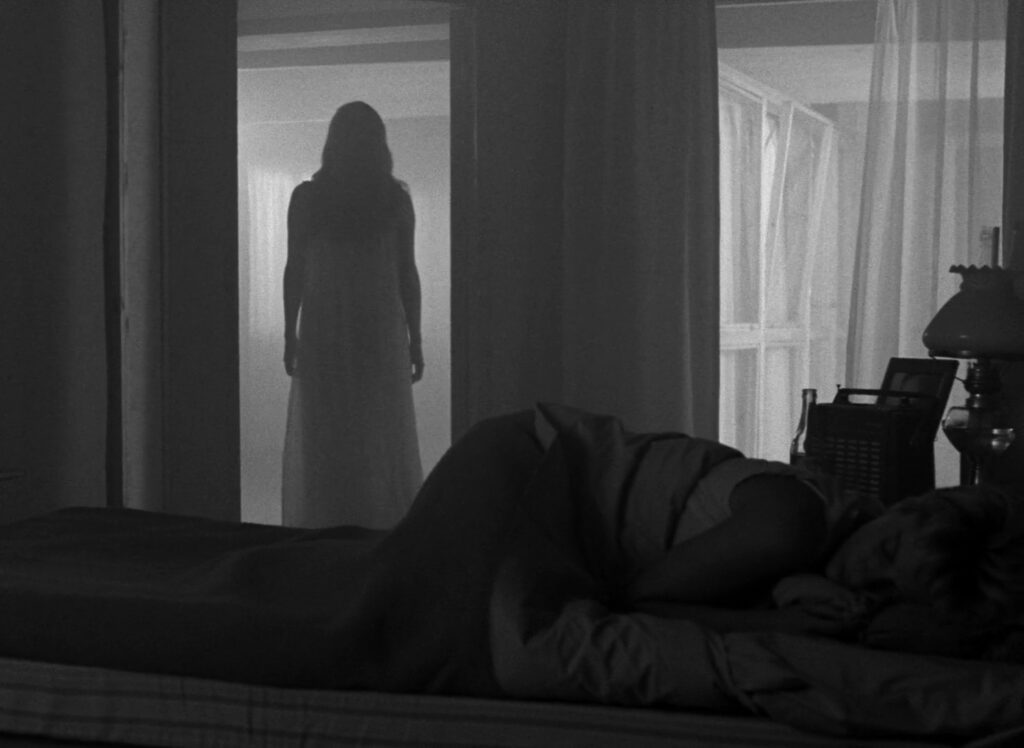
To say that ambiguity defines cinema does not mean that all movies are ambiguous. There are plenty of well made and respected films that get by without much ambiguity. They can feature outstanding acting, wonderful dialogue, clever direction, high production values, and exciting stories, but any two people who watch them can be expected to have roughly similar experiences. Movies with obvious social messages or clear conflicts between right and wrong, or movies that steer audiences toward a determined emotional response, tend to avoid ambiguity.
Ambiguity must not be confused with ambivalence. It does not mean that a movie lacks a definitive voice – it means that it allows the viewer to arrive at the same conclusion without coercion. Ironically movies speak more forcefully through ambiguity than through direct statement, because ambiguity reflects the complexity of reality and gives the viewer room to form ideas freely. The lesson of Persona is that ambiguity defines the essence of cinema, that movies only reach their potential when they allow multiple points of entry and multiple modes of viewing. The story of Alma and Elisabet suggests that ambiguity is a defining feature of life, and cinema reflects life when it too is ambiguous.
CONNECTIONS:
Spellbound – Ambiguity as to which of the two leads is the main character
Sunset Boulevard – Ambiguity as to which of the two leads is the main character
The End of Summer – Two women who are close to each other are sutured in a cut or split-screen that emphasizes their similarity
L’eclisse – Human narrative combined with seemingly avant-garde passage(s)
Pierrot le fou – Argument about a definition of cinema
Nostalghia – Two women’s faces brought together in a physical or imagined conflation
The Sacrifice – Character who gave up acting when troubled by the boundary between stage and life; compositions setting two faces at right angles to each other
Women on the Verge of a Nervous Breakdown – Women who feel split in two, both as actresses and as mothers
The Truman Show – Breaking the fourth wall; hand reaching out to touch a face on a large screen
Enemy – Ambiguity of identity between two main characters